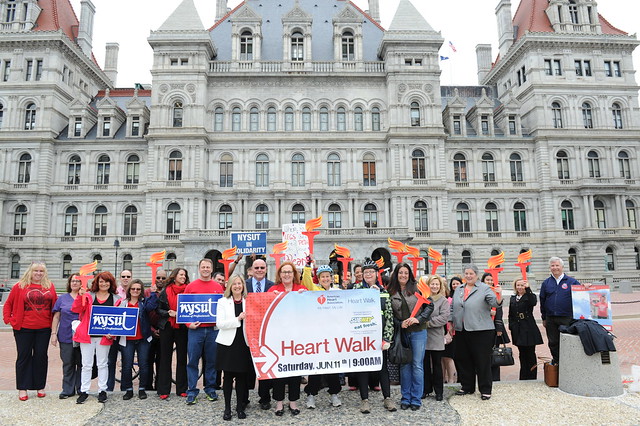Under cloudy skies and a flat grayness, Paula Symanski lit up State Street after a 20-mile spin and pedaled into the entrance of the Empire Plaza in Albany, where a crowd of American Heart Association supporters awaited her with flaming torches.
The torches were Styrofoam, but Symanski was real. She has recovered from a 2009 stroke, and now she is an ambassador for those who live with heart disease and stroke.
She led the torch ceremony along with NYSUT President Karen E. Magee, chair of this year’s Capital Region Heart Walk, which takes place on June 11, and Barbara Hess, chair of the Capital Region advisory board of the American Heart Association. The ceremony kicks off the countdown to the Heart Walk and gives participants and volunteers an opportunity to remember those who have died from strokes and heart attacks.
“You’re living. You’re an advocate. You’re here,” Magee told Symanski. She shared with the crowd that she lost her father to heart disease, and this is her motivation for getting involved. Heart disease is the biggest killer of women, she said, and females make up 70 percent of NYSUT’s membership.
Symanski began her bicycle trip at Ellis Medicine in Schenectady, where her stroke was diagnosed, and rode to Albany Medical Center, where she had her surgery. A surgeon who covered both hospitals was at Albany Med that night so she was taken there by ambulance for her procedure.

Riding in on pedal power was a lot different than being in the back of the ambulance. Today, she said, “I was comfortable. I was relaxed. I was healthy.”
Her stroke recovery was long and difficult, she said, and included precarious trips down her short driveway using a walker. But this is the stuff she’s made of: Frustrated by not being able to lift her arms over her head as she worked to regain everything, she constructed a loader out of PVC pipe in order to get her kayak on top of her car.
Although she describes herself as always having been fit, Symanski said cardiovascular disease and stroke runs in her family. She lost a great-grandmother, two grandmothers and an aunt to strokes.
“I had cannons pointed at me,” she said.
The risks of stroke include: family history, high blood pressure, obesity, high cholesterol and being sedentary.
Stroke signs include facial droop, slurred speech and inability to lift an arm. She urged anyone with these signs to get to the hospital emergency room, even if they are not sure. Even with TIA or transient ischemic attack – the warning stroke – a person loses brain cells, she said.
Wearing a bike helmet topped with a video cam to record her trip, Symanski said that last year she started riding her bike again, which she hadn’t done since childhood. She began preparing for today’s ride a few months ago. A resident of Malta in Saratoga County, she is the volunteer coordinator for Schenectady County Community Hospice.
“I see the effects of heart disease and stroke all around me everyday,” she said. She is joining the AHA on May 16 to lobby for state legislation to improve stroke care for all patients. Her state representative, Assemblywoman Carrie Woerner, D-Malta, joined Symanski at Thursday’s ceremony and said she is honored to advocate for people with these diseases.
Carrying a sign cheering on Symanski, Thelma Hill came to the ceremony to show her support for the cause. She’s been walking in the Heart Walk for as long as she can remember—long before she had open-heart surgery 19 years ago. She’s been a team captain since 2006, and brings the support of Alpha Kappa Alpha Sorority, Inc., which partners with the AHA, and Macedonia Baptist Church, which sponsors a team, she said.
Hill recalls feeling tired a lot and eventually going to the doctor with chest pains. The doctor said she had pleurisy. Hill didn’t feel that’s what she had, and she went to the emergency room where a catheterization showed the problem. She’d had rheumatic fever as a child, she said.
Now, Hill said, she walks in the annual event “to be an example of what exercise and good eating and having a good life” is all about.